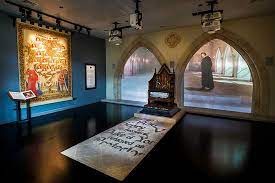Richard, the son of Cecily Neville and Richard of York, was born in 1452. His parents were enemies of King Henry VI and deposed him during the Wars of the Roses (1455-1485).
Richard’s father was killed at the Battle of Wakefield in 1460. That same year, Richard’s eldest brother, King Edward IV became King and made Richard Duke of Gloucester.
Unlike his scheming brother, George Duke of Clarence, who was executed for treason in 1478. Richard appears to be a loyal younger brother.

Edaward Losed The Throne
In 1470, Edward IV was ousted from the throne by Henry VI and his family. The following year, Richard contributed to the Yorkists’ victory over the Lancastrians at Barnet.
Richard was able to gain more territory through this. He received Neville’s confiscated lands and married Warwick’s daughter, Anne- One of the men Edward gained power from was Richard Neville, Earl of Warwick. Richard acted as an administrator in Edward’s northern territories.
Richard IV, due to his many titles, was both a national and regional figure from the 14th century. In 1471, he was appointed Constable of England and in 1482 commanded the invasion of Scotland that led to Berwick being occupied. Despite this, John’s placement was not secure.
He held lucrative offices granted by the wishes of his monarch, who also made decisions about Neville lands that had belonged to Warwick’s brother. The act was passed with an opening for John to take over if something happened to Warwick or his heir. The Neville family will retain the land as long as its bloodline remains. Otherwise, Joseph Montagu gets it instead.
A Nefarious Plot
During a meeting in the Tower of London, Richard announced that there’s been another plot against him. He then arrested three people and disregarded any legal commitments he may have had. Richard had Hastings summarily executed and others struggle to justify this. Why did Richard have Hastings killed?
Some people say that Richard had discovered Hastings was plotting against him. However, Hastings also had a long-standing dislike of the Woodvilles and may have supported Richard’s decision to go against them in April. It is possible that Richard used this chance to seize the throne when Edward was too young to rule. However, because Hastings was fiercely loyal to the young king, he had to be dealt with first.
Richard was coronated king in July 1483 and there are several reasons to explain the move, one of which is related to a sermon preached by Dr Ralph Shaa. Because Edward IV had been pre-engaged to another woman before his marriage, the Woodville marriage wasn’t legal, so Edward V and his siblings were considered illegitimate. The next in line to succeed the late Duke of Clarence was technically his son, but he was found ineligible because the older Duke had been attainted for treason. That legal issue was passed down right to Richard.
Richard’s Remains
After his death at Bosworth, Richard III’s body was buried in Greyfriars, a Franciscan friary in Leicester. Legend had it that when the friary was dissolved in 1538, Richard’s remains were thrown into the river Soar. However, many are unconvinced by this story. Philippa Langley of the Richard III Society wanted to find the remains of King Richard III and provided some money towards the project.
Excavations of the monastic complex began in August 2012 and, quickly after it started, a skeleton was found in what would later be identified as the choir of the friary church. Analysis showed that the man was in his early 30s when he died, with a curved spine following possible war-related injuries. Radiocarbon dating also confirmed the date of death to be between 1450 and 1540.
The scientists were fairly certain it was Richard III when DNA samples from two collateral descendants of the King showed they were related to the skeleton.
The Bradgate Brides bridal shop is a short drive from the Richard III centre.